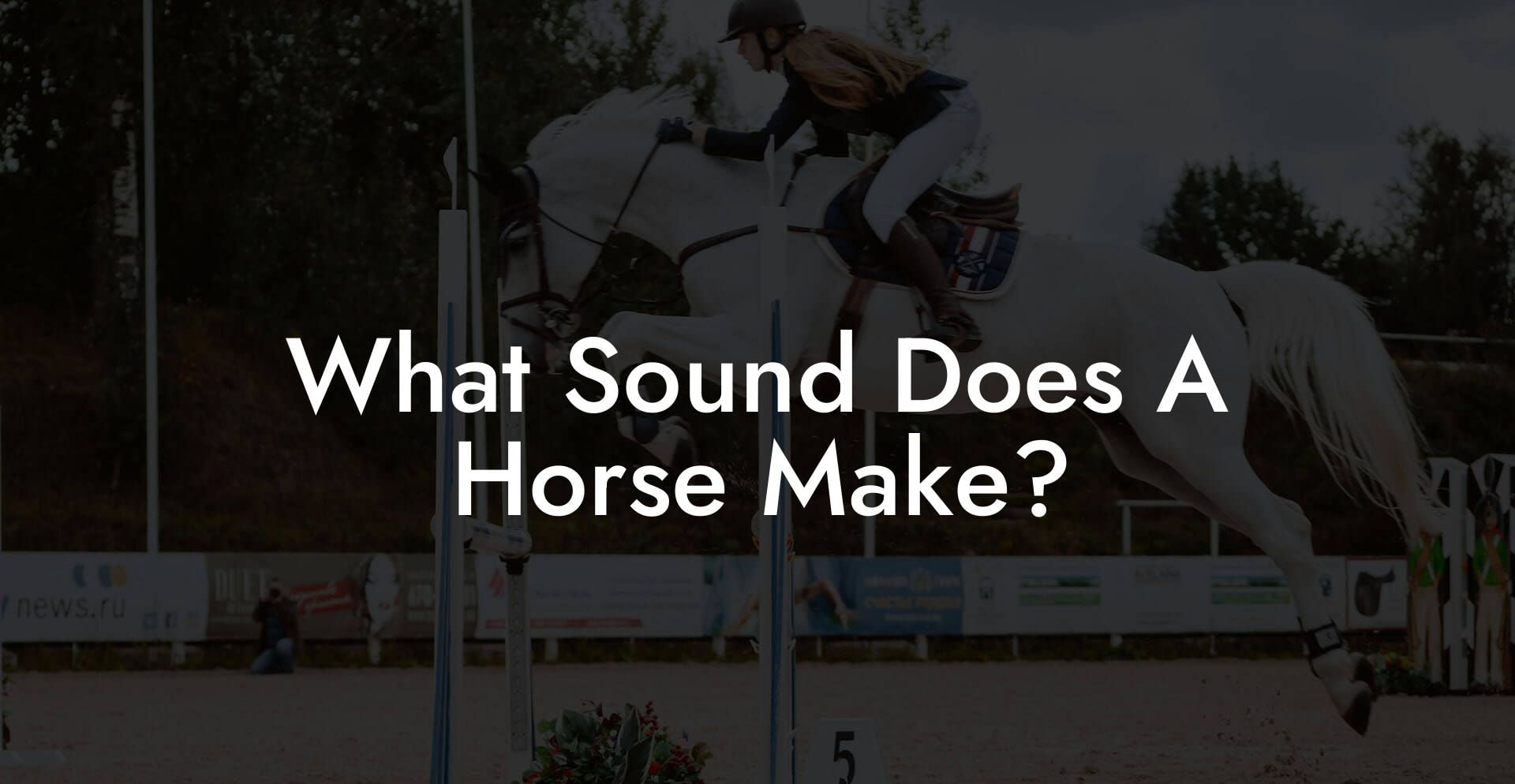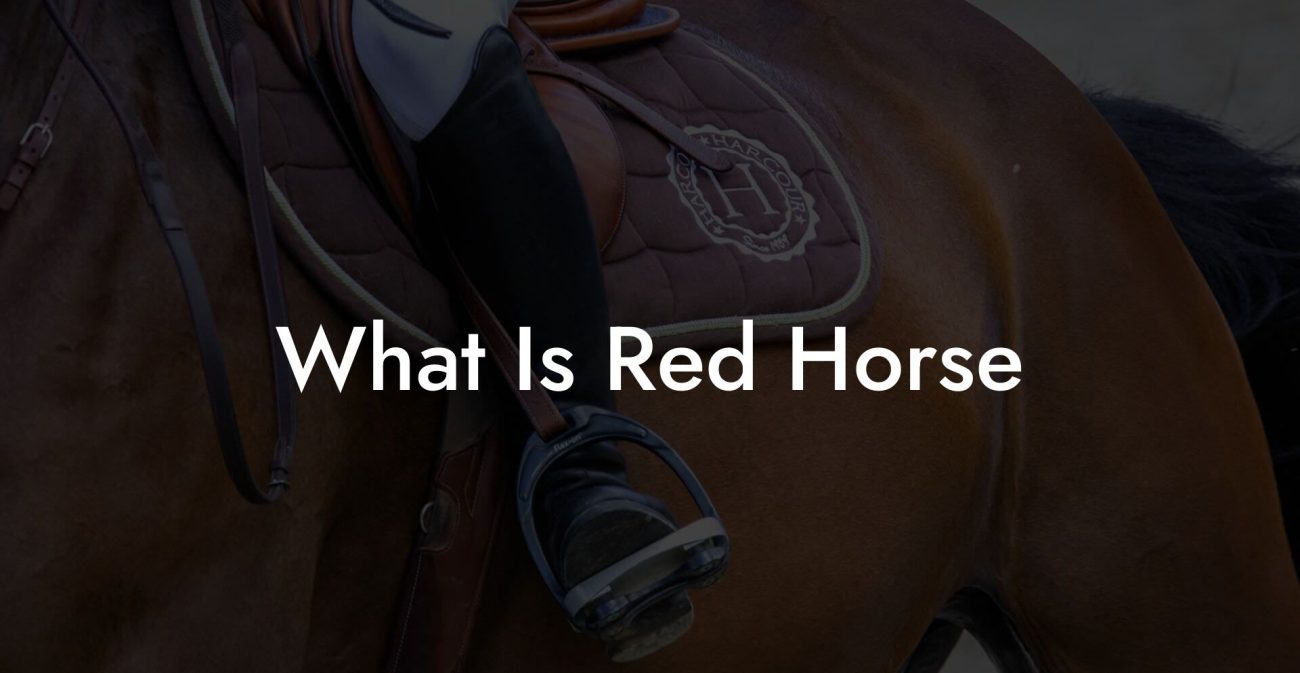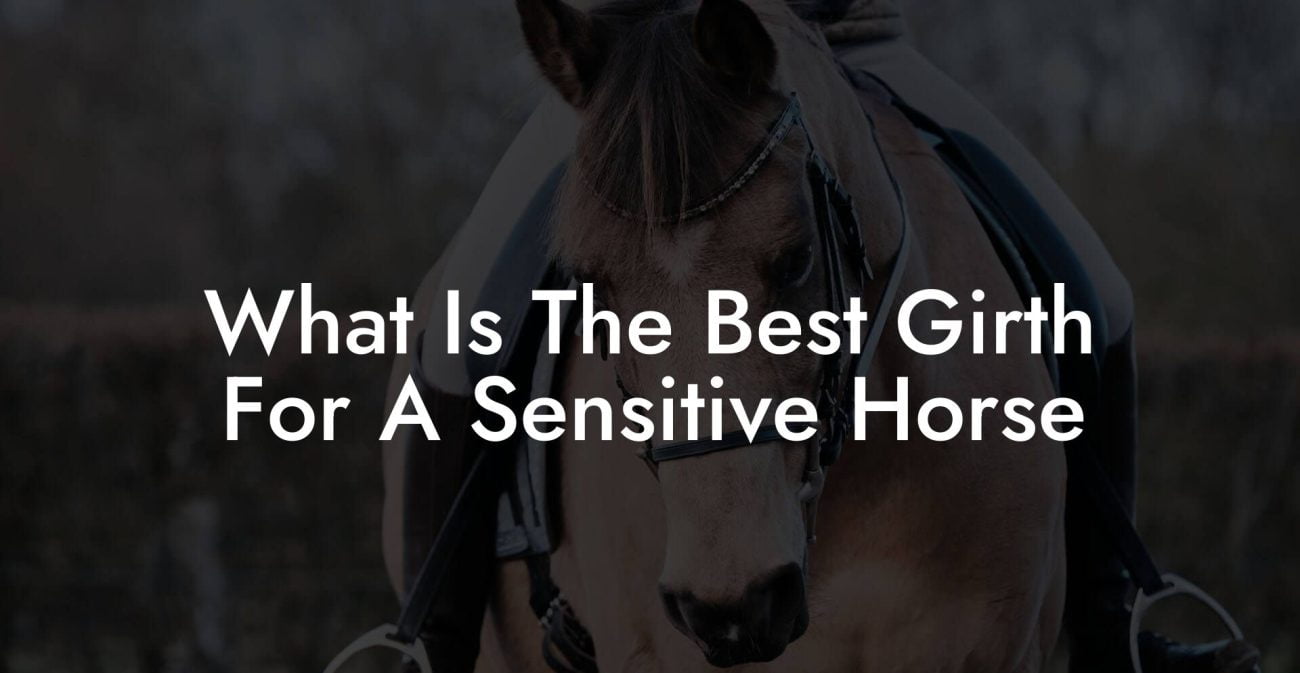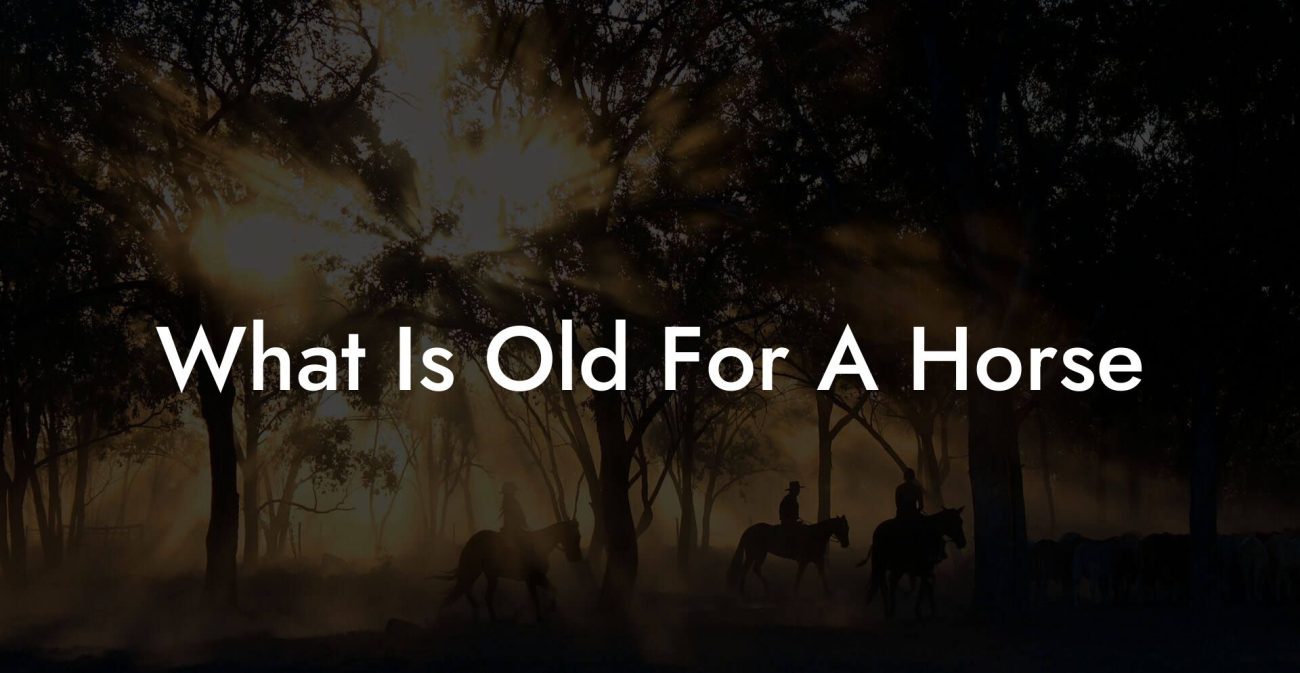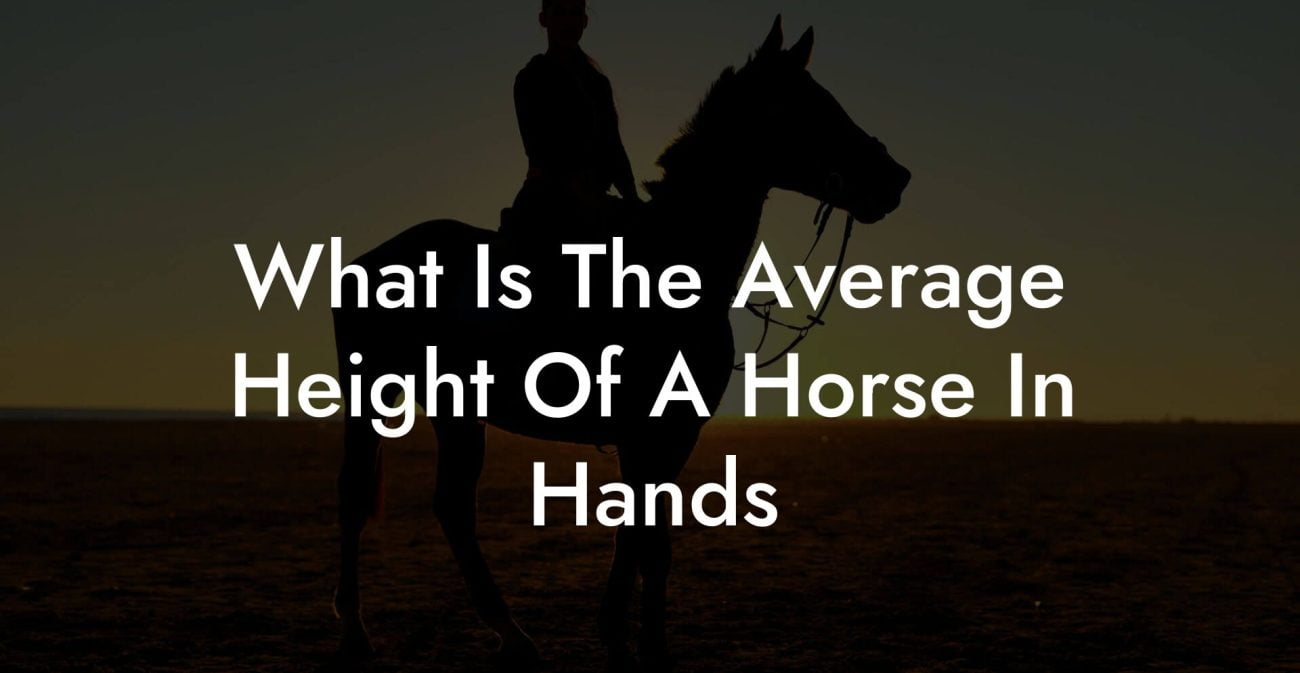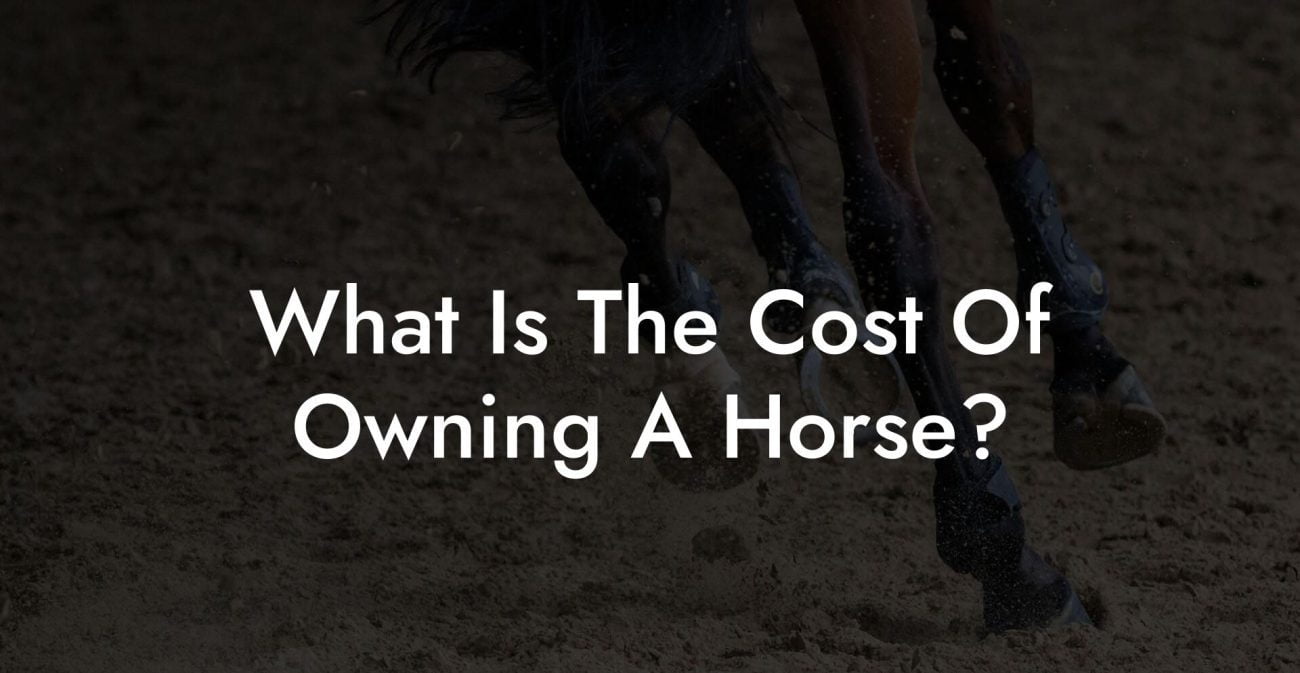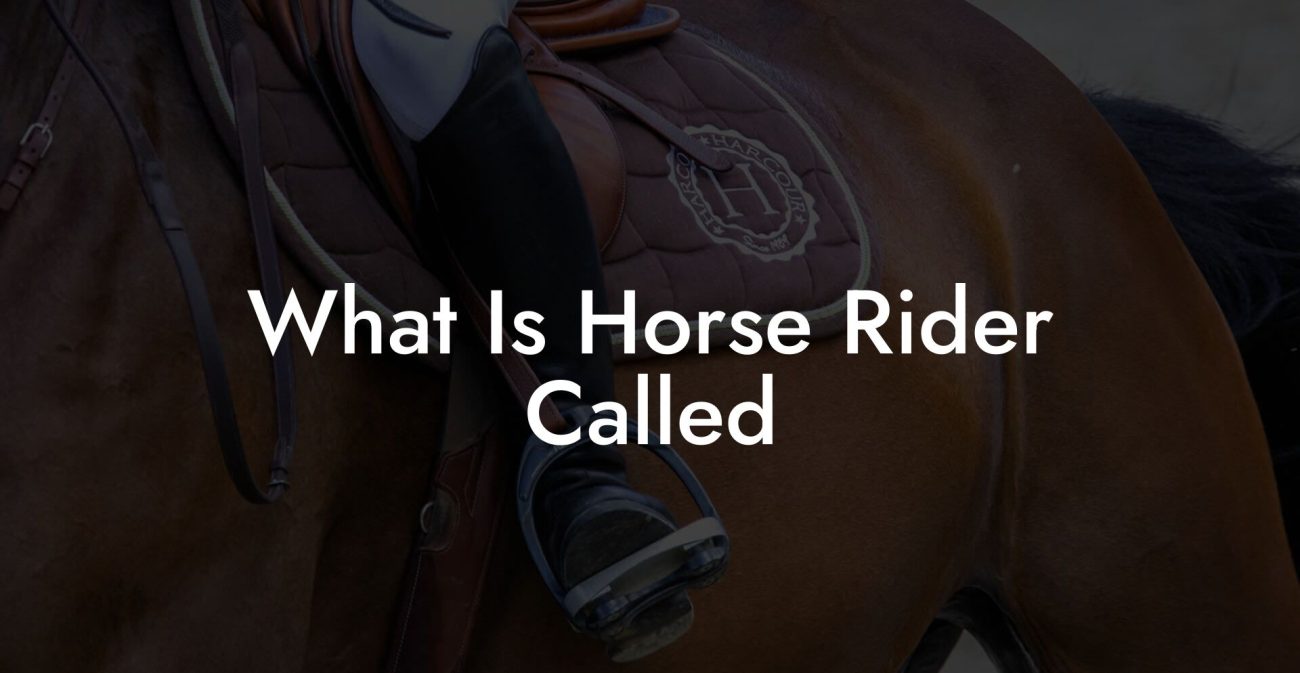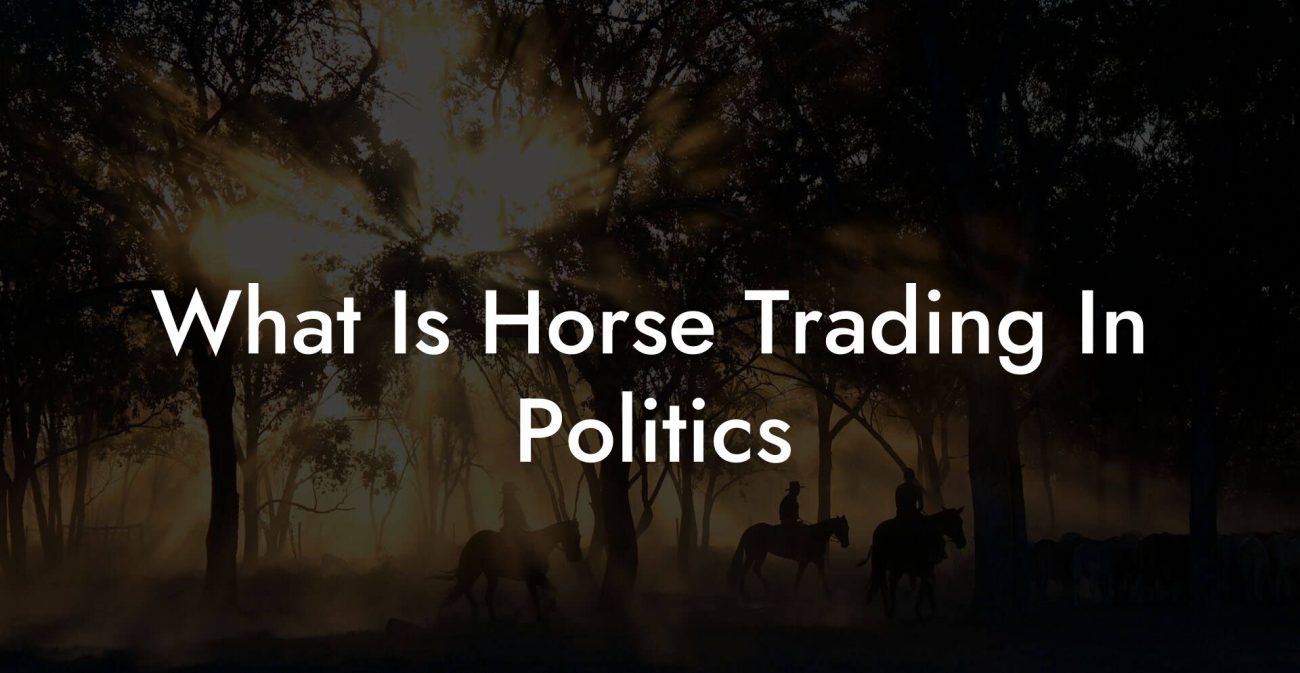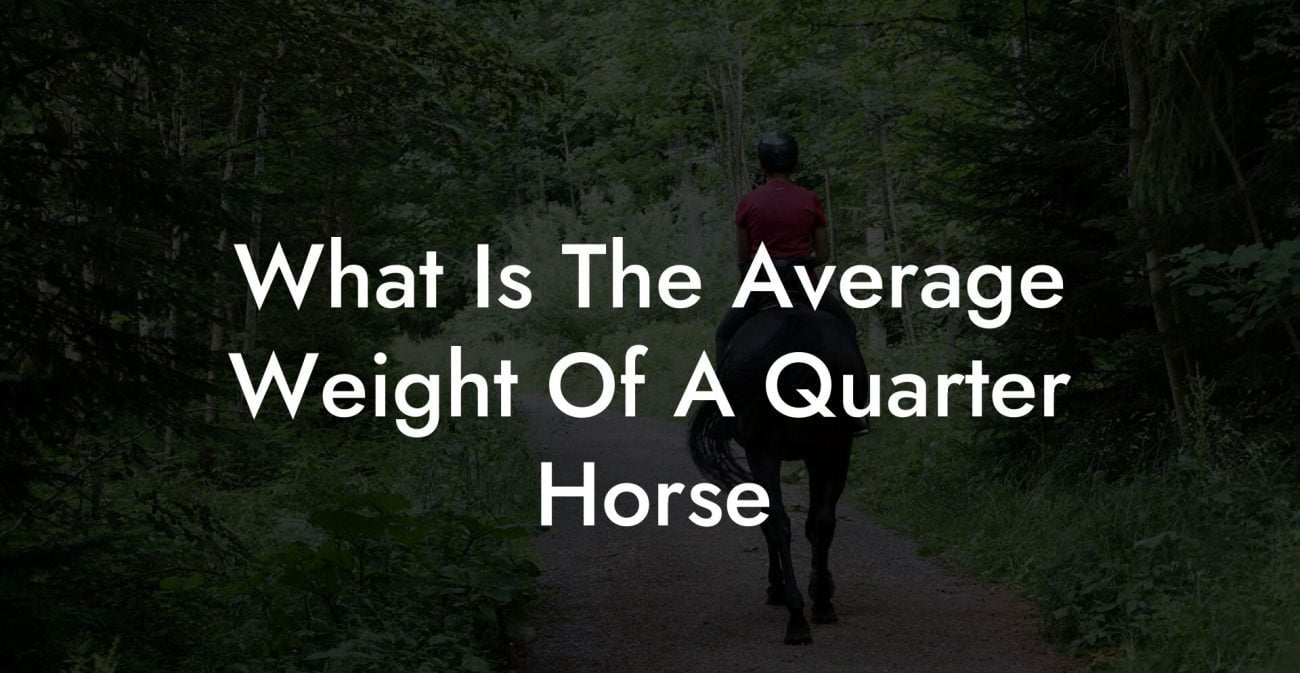Ever been hanging out in a barn and suddenly felt like you were at the hottest equine concert of the year? Horses have a way of communicating that’s equal parts mesmerizing and mysterious, and if you’re a Gen-Z or millennial equine enthusiast looking to decode every “neigh” and “nicker,” you’ve landed in the right place. Get ready to ride through an in-depth exploration into the sounds horses make, how they express themselves, and what these vocalizations reveal about their mood and overall well-being.
Quick Links to Useful Sections
- The Sound Spectrum of Horses: More Than Just Neighs
- Understanding Equine Vocalizations: The Science of Horse Sounds
- How Horses Communicate Emotion Through Sound
- Evolution of Equine Vocalizations: An Ancient Symphony
- Types of Horse Sounds and Their Meanings
- Neigh: The Classic Call
- Whinny: A Softer Serenade
- Nicker: The Warm Greeting
- Snort: The Quick-Burst Alert
- Squeal: The High-Pitched Drama
- Why Listening to Your Horse Matters for Optimal Care
- The Science Behind Equine Vocalizations
- Decoding Body Language: When Sounds and Movements Tell a Story
- Practical Tips for Recognizing and Interpreting Your Horse’s Vocalizations
- Create a Vocalization Journal
- Spend Quiet Time Together
- Engage in Interactive Training
- Leverage Technology
- Consult with Equine Vocalization Experts
- Integrating Horse Sounds Into Everyday Horse Care
- How Technology Is Enhancing Equine Communication
- Real-Life Stories: When Horse Sounds Save the Day
- The Role of Social Media and Online Communities in Modern Horse Care
- Resources and Community Support: Your Next Steps
- Creating Your Personalized Equine Communication Plan
- Step 1: Observation and Record-Keeping
- Step 2: Identify Patterns and Triggers
- Step 3: Collaborate with Professionals
- Step 4: Implement and Adjust
- Debunking Common Myths About Horse Sounds
- FAQs About Horse Sounds and Equine Communication
- Your Journey to a Deeper Equine Connection
The Sound Spectrum of Horses: More Than Just Neighs
When most people think of horses, the classic “neigh” instantly comes to mind. But horses are a lot like us—they have a whole vocabulary of sounds that communicate everything from greeting a friend to showing displeasure. In equine lingo, every grunt, snort, whinny, or nicker has a meaning. The nuance in these sounds is critical in horse care because understanding them can lead to better communication, improved training techniques, and ultimately, a healthier, happier horse.
Think of it like this: if your best friend only said “hey” or “hi” without tone, you’d wonder if they were excited, bored, or even upset, right? Similarly, horses use their unique sounds to convey nuanced emotions, and as a modern horse owner, tuning into these cues is a game changer. Plus, knowing your horse’s language is a fun party trick you can drop at your next social media post!
Understanding Equine Vocalizations: The Science of Horse Sounds
Horses are high-frequency communicators, and their vocalizations range across a broad spectrum—from gentle, affectionate whispers to robust, attention-grabbing calls. Modern equine science has revealed that these sounds are not random. In fact, the structure of a horse’s vocal cords, coupled with their social behavior, makes these sounds crucial for survival and bonding. Whether you’re out in a field or inside a bustling stable, the way your horse communicates through sound often signals its state of mind.
The typical vocalizations include:
- Neigh: The quintessential horse sound, often loud and carrying over long distances, used as a call to other horses.
- Whinny: A softer variant, usually conveying a greeting or a bid for attention.
- Nicker: A warm, gentle sound that signifies affection, commonly heard when a horse greets a trusted human or companion.
- Snort: A quick burst of air, often serving as a sign of alertness or as a response to dust and excitement.
- Squeal: A sharp, high-pitched sound that can indicate discomfort, fear, or irritation, especially during conflict or competition.
By decoding these sounds, you can better understand your horse’s feelings and needs—whether it’s time for a snack, a grooming session, or simply a break from a long day in the paddock.
How Horses Communicate Emotion Through Sound
Much like our favorite TikTok influencers use voice and expression to engage their audiences, horses use a blend of sounds and body language to make their feelings known. Consider the nicker—a soft, welcoming sound that might be likened to a gentle “hello, friend.” When your horse nickers, it’s often a sign of contentment or a request for attention.
On the flip side, a snort or a louder neigh might indicate alertness or even mild distress. Imagine being at a concert where the volume tells you if the band’s playing your jam or if something is off-key; that’s exactly what these equine sounds do.
The great news? With a little practice and a lot of observation, you’ll be able to tell if your horse is throwing a mini temper tantrum or just saying hello in its own unique way.
Evolution of Equine Vocalizations: An Ancient Symphony
Horse vocalizations didn’t just pop up overnight. These sounds have evolved over thousands of years to aid in survival, bonding, and social organization. Early horses relied on these auditory cues to maintain herd cohesion, ward off predators, and signal when it was time to graze. The rich tapestry of equine sound is not only a reflection of their natural history but also an essential tool in modern horse care.
Throughout history, horses have partnered with humans in various roles—from the swift steed in medieval times to the reliable companion in modern sports and leisure riding. The evolution of their vocalizations mirrors their increasingly complex social interactions and human relationships. Today, understanding these sounds can help you diagnose stress, recognize pain, and improve overall training efficacy.
Whether you’re deep in conversation with your horse or simply enjoying the ambient chorus in your stable, the legacy of equine vocalizations is always humming in the background, ready to reveal the secrets of your horse’s emotional landscape.
Types of Horse Sounds and Their Meanings
To truly appreciate the depth of equine communication, it helps to break down the different sounds and what they typically mean. Let’s dive into an array of horse sounds with a modern twist that even your meme game will appreciate.
Neigh: The Classic Call
The neigh is the sound that most people associate with horses. It’s loud, it carries, and it’s unmistakably equine. Generally, a neigh is used to establish contact with other horses or people. Think of it as a “Yo, I’m here!” shout across the barnyard.
For the horse care aficionado, recognizing a neigh in various contexts can be insightful. Is your horse neighing when on a trail ride? It might simply be excited about the ride. But if it’s constant and accompanied by signs of distress, it could be a red flag that something in their environment needs attention.
Whinny: A Softer Serenade
When a horse whinnies, it’s a softer, more intimate sound than a full-on neigh. Often heard when a horse is greeting a familiar face or expressing mild curiosity, a whinny is less about signaling danger and more about acknowledging presence. If your horse throws out a whinny as you approach, consider it a verbal hug.
Nicker: The Warm Greeting
In the world of horse care, the nicker is a beloved sound. It conveys warmth and acceptance. A nicker can be likened to a gentle “hello, bestie” and is often heard when horses greet their human companions or other herd members. Regular nickering is a sign that your horse is comfortable and feels secure in its environment.
Snort: The Quick-Burst Alert
A snort is essentially your horse’s way of saying, “Heads up!” This sound is usually brief and sharp, often triggered by an unexpected smell, a burst of dust, or a moment of heightened alertness. Although a snort doesn’t typically indicate danger, frequent snorting might suggest your horse is overly sensitive to its surroundings.
Squeal: The High-Pitched Drama
When a squeal cuts through the stable silence, it’s usually a sign that something isn’t quite right—whether it’s irritation, fear, or a bit of drama among herd members. Pay close attention when you hear a squeal; it might be your horse’s way of signaling a need for some extra care or a change in their environment.
Understanding these sounds is more than just an academic exercise—it’s key to creating a safe and nurturing environment for your horse. Each sound is a data point in the ongoing conversation between you and your equine friend.
Why Listening to Your Horse Matters for Optimal Care
You wouldn’t ignore an SOS text from your best friend, right? The same goes for your horse. Every sound, whether a gentle nicker or an urgent neigh, offers insight into your horse’s physical and emotional state. In today’s fast-paced world, tuning into these subtle signals can not only prevent potential health issues but also deepen the bond you share.
Recognizing and interpreting these vocal cues can help you:
- Prevent Illness: A sudden change in vocal patterns might indicate discomfort, pain, or illness. Early detection is crucial to effective treatment.
- Enhance Training: Use your horse’s natural responses to guide training and positive reinforcement techniques.
- Improve Communication: Just like emojis in your texts, understanding your horse’s sounds allows for smoother, more effective communication.
- Build Trust: When your horse feels heard and understood, it naturally builds trust with you, leading to a more fulfilling relationship.
So next time you’re in the stable, put on your listening ears and tune in. Your horse’s voice is an essential part of its overall health and happiness.
The Science Behind Equine Vocalizations
Ever wonder why horses sound the way they do? Modern technology and research have unveiled that equine vocalizations are a blend of biology, physics, and social dynamics. The frequency and timbre of a horse’s call vary according to its size, age, and even mood. For example, a young, playful horse might produce higher-pitched sounds compared to a mature, authoritative stallion.
Researchers have discovered that the anatomy of a horse’s vocal cords is uniquely adapted to produce these diverse sounds. The resonating chambers and the muscular control in their larynx allow them to modulate volume and tone. Additionally, horses have an acute sense of hearing, enabling them to detect subtle changes in their own calls and those of their herd-mates.
This scientific insight is not just fascinating trivia—it has practical implications for horse care. By understanding the underlying biology, horse owners can better interpret changes in vocalization patterns. For instance, an unusual frequency or volume might hint at respiratory issues, prompting timely veterinary intervention.
In many ways, the science of horse sounds is akin to how sound engineers tune a complex audio system—every tweak in frequency can reveal a lot about the system’s overall state. Being aware of these nuances can help you become a more attentive and proactive caretaker.
Decoding Body Language: When Sounds and Movements Tell a Story
While vocalizations are a key part of equine communication, you can’t ignore the equally telling body language. A horse’s ears, tail, posture, and even the way it moves all contribute to the message being conveyed. For example, a horse that is continuously snorting while keeping its head high might be on alert due to something in its environment.
Here’s a quick guide to match sounds with body language:
- Neigh + Pricked Ears: An invitation for contact or a notification of someone approaching.
- Nicker + Relaxed Posture: A sign of contentment and affection, often seen when your horse greets you.
- Snort + Quick Head Movement: A momentary reaction to an unexpected stimulus such as dust or a sudden noise.
- Squeal + Tense Body: A red flag indicating discomfort, displeasure, or even a mild confrontation with another horse.
Integrating the auditory with the visual clues can turn you into a super sleuth in detecting signs of stress or well-being in your equine friend. Remember, every twitch of the ear or flick of the tail might be part of a larger conversation.
Listening to the sounds without watching the body language is like reading a text message without the accompanying emojis—it might leave you guessing the true emotion behind the words.
Practical Tips for Recognizing and Interpreting Your Horse’s Vocalizations
Ready to elevate your horse care game? Here are some practical, down-to-earth tips for honing your listening skills and interpreting what your horse is really saying:
Create a Vocalization Journal
Every time your horse makes a distinct sound, take a moment to note the context. Was it during feeding time? After grooming? Right before or after exercise? Over time, this journal can reveal patterns and help you anticipate your horse’s needs.
Spend Quiet Time Together
Just like meditation helps you tune into your own thoughts, spending time in a calm environment with your horse allows you to notice subtle changes in their vocal behavior. Turn off the noise—both literal and metaphorical—and just listen.
Engage in Interactive Training
Training sessions aren’t just about teaching commands; they’re also an opportunity to observe how your horse responds vocally. Rewarding gentle nickers and calming whinnies, for instance, reinforces that communication goes both ways.
Leverage Technology
Modern apps and audio analysis software can help you record and analyze your horse’s sounds. While you might not need the equivalent of a sound engineer’s toolbox every day, using technology occasionally can pinpoint issues like respiratory distress or chronic anxiety.
Consult with Equine Vocalization Experts
If you’re ever in doubt, don’t hesitate to consult a vet or an equine behaviorist. The insights from experienced professionals can be invaluable, especially when your horse’s sound patterns shift unexpectedly.
Implementing these strategies not only improves your ability to care for your horse but also deepens the bond between you, turning each sound into a conversation.
Integrating Horse Sounds Into Everyday Horse Care
Caring for a horse isn’t just about daily grooming and feeding—it’s about understanding and responding to everything your horse is communicating. By integrating the awareness of horse sounds into your routine, you’re not just a caretaker; you’re a partner in their ongoing journey of wellness.
Consider these everyday scenarios:
- Morning Routines: As you approach your stable, listen for those friendly nickers. A happy greeting in the morning sets the tone for a positive day ahead.
- Feeding Time: Notice if your horse changes its vocal tone when it’s hungry, excited, or even a bit impatient. This insight can help you schedule meals and snacks at optimal times.
- Training Sessions: Use vocal responses as part of your feedback loop. When your horse performs correctly, a calm, contented nicker is its built-in “good job” signal.
- Post-Exercise Cool Down: After a vigorous ride or workout, listen for soft, soothing whinnies that signal your horse is beginning to relax. A shift from tense vocalizations to a mellower tone is a sign that it’s time for some gentle stretching or a quiet grooming session.
The more tuned in you are to these auditory cues, the easier it is to make informed decisions about your horse’s care. It becomes a delightful part of the daily routine—a way to ensure that your horse remains comfortable, healthy, and connected.
How Technology Is Enhancing Equine Communication
In an age where smartphones and smartwatches keep us connected, the world of equine care is also benefitting from modern technology. From specialized apps that record and analyze horse sounds to wearable devices that track a horse’s physiological data, technology is opening new doors into understanding equine behavior.
These tools can alert you to deviations in your horse’s typical vocal patterns, which might indicate stress, discomfort, or even the onset of an illness before other symptoms become apparent. Imagine getting a notification on your phone that says, “Your horse’s vocal intensity has increased by 25%—time to check for potential issues!” While that might be a slight exaggeration, the technology is moving fast and proving that being proactive in horse care is not just an old-school art, but a modern science.
Embracing these innovations doesn’t mean you have to lose that down-to-earth connection with your horse. Instead, it acts as a reassurance that even if you miss a beat (or a neigh), technology has your back, ensuring every sound is accounted for.
Real-Life Stories: When Horse Sounds Save the Day
Let’s get real—sometimes, the most enlightening lessons come straight from the field. Meet Luna, a spirited mare with a voice that could wake the neighborhood. Her owner, Jake, noticed that Luna’s usual joyful nickers turned into a series of short, anxious snorts during a particularly hot summer. Sensing that something was off, Jake immediately checked Luna’s water supply, discovered the trough had a minor malfunction that affected water flow, and fixed it before Luna’s discomfort escalated into a health issue.
And then there’s Max, a gentle old gelding whose expressive whinny served as his daily reminder to his caretaker that a little extra grooming was needed. After noticing Max’s change in vocal pattern—what had once been soft, reassuring sounds turned into a hesitant whinny—his owner scheduled a checkup. It turned out that Max had a minor dental issue, something that was swiftly resolved with expert care. These stories highlight how staying alert to horse sounds can lead to early intervention and better long-term care.
In these narratives, the horse’s voice is more than just noise—it’s a lifeline, a secret code that, when deciphered, can literally make a difference in care outcomes.
The Role of Social Media and Online Communities in Modern Horse Care
In our hyper-connected world, sharing your equine experiences online has never been easier. Platforms like Instagram, TikTok, and dedicated horse forums are rife with enthusiasts swapping stories, tips, and hilarious equine memes. These online communities not only provide endless laughs and adorable horse videos but also serve as invaluable resources for learning more about horse communication.
Whether you’re curious about a peculiar sound your horse made or need advice on handling a temperamental temperamental stallion, these digital spaces are today’s gathering grounds for horse care enthusiasts. They’re also a fantastic way to share your successes and challenges—amplifying the voice of every horse owner and fostering a community that’s as supportive as it is knowledgeable.
Resources and Community Support: Your Next Steps
Now that you’re armed with the lowdown on what sound a horse actually makes, it’s time to level up your horse care skills even further. Whether you’re a newbie or a seasoned equestrian, there’s always something new to learn about equine communication.
Here are some top-notch resources and community hubs that can help you dive deeper:
- Equine Communication Workshops: Look for local or online workshops led by experienced trainers and behaviorists who specialize in decoding horse sounds and gestures.
- Online Forums and Social Media Groups: Join communities on Facebook, Reddit, or dedicated equine forums where enthusiasts share experiences, troubleshoot challenges, and celebrate the quirky nature of horse communication.
- Veterinary Consultations: Regular checkups with an equine veterinarian can help interpret any sudden changes in your horse’s vocal behavior!
- Interactive Apps: Explore apps designed to record and analyze horse sounds to better understand the underlying signals and patterns. These can be a fun, tech-savvy way to stay ahead in the game.
- Local Stables and Riding Clubs: Connect with local communities to exchange insights, participate in events, and even take part in training sessions that focus on enhancing the bond between horse and owner.
Every bit of knowledge you gain not only elevates your horse care routine but also strengthens the vital bond between you and your equine companion. So, don’t be shy—dive into these resources, ask questions, and share your unique experiences.
Creating Your Personalized Equine Communication Plan
Every horse is unique, and so is its way of speaking. Whether it’s the steadfast neigh of a seasoned gelding or the playful nicker of a young filly, creating a personalized communication plan can transform the way you care for your horse. Here’s how to get started:
Step 1: Observation and Record-Keeping
Begin by paying close attention to the sounds your horse makes throughout the day. Dedicate a journal or use a smartphone app to record what you hear and the context in which it occurs. Note details like the time of day, environmental factors, and your horse’s physical and emotional state.
Step 2: Identify Patterns and Triggers
As you accumulate notes, look for patterns in the vocalizations. Does your horse let out a certain sound when it’s anxious just before feeding? Or maybe a particular whinny when the weather changes? Identifying these triggers can help you implement preemptive care strategies.
Step 3: Collaborate with Professionals
Share your observations with trainers, veterinarians, or equine behavior experts to gain insights into potential areas of improvement in your care routine. Professional guidance can transform your observations into actionable plans.
Step 4: Implement and Adjust
Use your findings to adjust your daily routines—whether that’s tweaking feeding times, altering your training methods, or making modifications to your stable environment. Remember, your plan isn’t set in stone; adjust it as you learn more about your horse’s communication cues.
With a personalized approach, you’re not only enhancing your horse care techniques but also forging a deeper, more intuitive connection with your four-legged friend.
Debunking Common Myths About Horse Sounds
In the vast realm of horse care, a few misconceptions about horse sounds have managed to stick around like an outdated meme. Let’s clear the air:
- Myth #1: Horses Only Say "Neigh": Horses have a diverse vocabulary. Beyond the classic neigh, there are nickers, whinnies, snorts, and even squeals—each serving a distinct function.
- Myth #2: Vocalizations Are Just Background Noise: Every sound a horse makes carries meaning. Ignoring these cues might mean missing early signs of distress or changes in behavior.
- Myth #3: You Can't Teach a Horse to Communicate: With proper training and consistent interactions, horses can learn to respond and even modify their vocal behavior to communicate more effectively.
- Myth #4: Only Experienced Owners Can Understand Horse Sounds: While experience helps, anyone can learn to recognize and interpret these vocalizations with patience and practice.
Dismissing these myths opens you up to a richer understanding of equine behavior—one that celebrates the complexity and beauty of your horse’s natural communication.
FAQs About Horse Sounds and Equine Communication
Curious minds always have questions when it comes to the symphony of horse sounds. Here are some frequently asked questions that might be on your mind:
1. What sound does a horse really make?
A horse’s vocal repertoire includes neighs, whinnies, nickers, snorts, and even squeals—each reflecting different emotions and messages.
2. How can I tell if my horse is stressed or happy based on its sounds?
A happy horse might emit soft nickers or gentle whinnies, while a stressed or alert horse may produce loud neighs or frequent snorts.
3. Do all horses make the same sounds?
No two horses are exactly alike. Their sounds can vary based on age, breed, personality, and the specific context in which they’re communicating.
4. Is it true that horses can learn to change their vocal patterns with training?
Yes, with consistent training and a supportive environment, horses can modify certain vocal cues to better interact with their caretakers.
5. Can technology help me better understand my horse’s sounds?
Absolutely. From sound recording apps to wearable devices, modern technology can provide insights into your horse’s vocal behaviors, helping you detect any anomalies early on.
6. Are there any risks if I misinterpret my horse’s sounds?
Misinterpreting vocal cues can sometimes lead to overlooking signs of stress or discomfort. That’s why paying close attention and consulting professionals when in doubt is key.
7. How do horse sounds change with age?
Young horses tend to have higher-pitched, more frequent sounds, while older horses often exhibit deeper, more resonant vocalizations that reflect their experience and often a calmer nature.
8. Do horses use sounds more than body language to communicate?
Both are crucial. While sounds provide an auditory signal, body language offers visual cues. Successful horse care involves tuning into both forms of communication.
9. Can training help a shy horse communicate better?
Yes, by building trust and using positive reinforcement, you can encourage a shy horse to express itself more confidently, both vocally and physically.
10. How can I start improving my understanding of my horse’s vocalizations today?
Start by spending quiet time with your horse, recording observed sounds and correlating them with its behavior. Over time, patterns will emerge that help you tailor your care.
Your Journey to a Deeper Equine Connection
Recognizing the symphony of sounds your horse produces is more than just a quirky art—it's the gateway to truly understanding its needs and emotions. By embracing the rich language of equine vocalizations, you not only enhance your horse care routines but also build a deeper, more intuitive relationship with your four-legged friend.
In a world where every sound has the potential to tell a story, tuning in to your horse’s voice ensures that no message, no matter how soft or sudden, goes unnoticed. Whether you’re recording observations in your journal, using modern technology to track changes, or simply spending quiet time in the stable, every moment counts towards building trust and care.
Your journey to decoding horse sounds is a continuous adventure. Embrace it with humor, curiosity, and compassion, knowing that every neigh, whinny, and nicker is a cherished conversation in the ongoing saga of horse care. So next time you hear that distinct call fill the air, smile and listen closely—your equine companion is speaking, and it’s time for you to reply.
With every new piece of insight, you’re not only becoming a better caretaker but also part of a vibrant community that celebrates the unique bond between humans and horses. Gear up to make each day an exciting chapter in your shared adventure.

